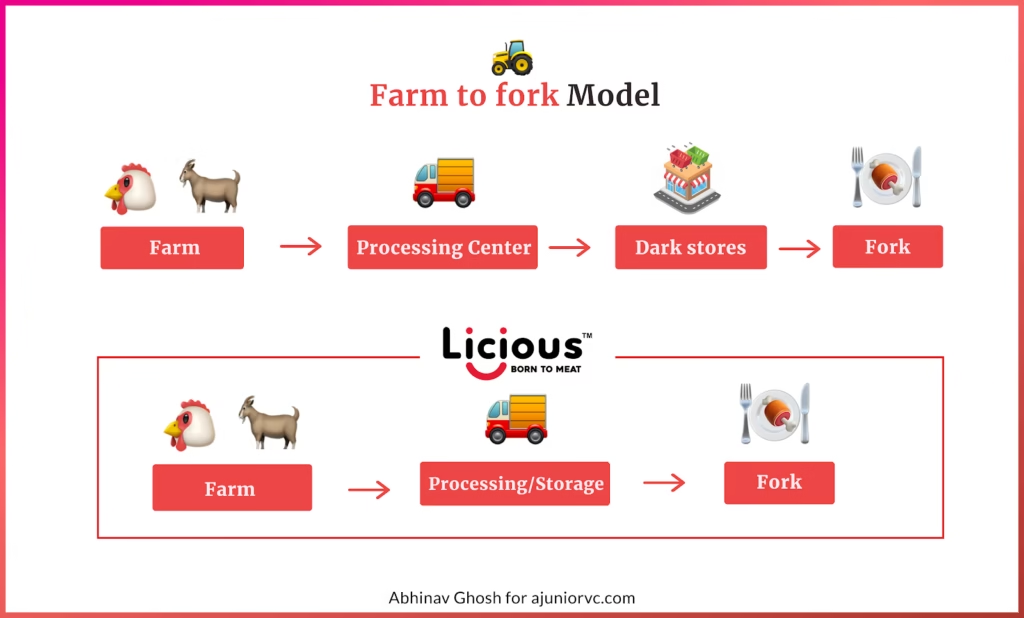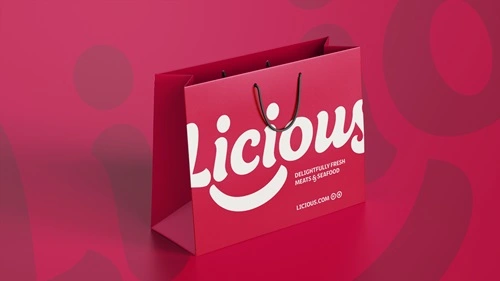If you are a non-vegetarian lover, you must have been familiar with Licious, which became a unicorn in October 2021. And you want to know about licious business model stay tune with us.

“Did you know that Licious delivers over 1 million orders monthly with over 90% repeat customers?”
Licious is a Bangalore based direct to consumer (D2C) meat and seafood startup that provides the best non-vegetarian products, including fresh fish, seafood, crave mutton, prawns, etc., to the customers. The company also possesses Food Safety System Certification (FSSC), which ensures high-quality food.
In this article, we have discussed how Licious started, Licious business model, its competitors, and Licious revenue model.
Let’s explore how the business model of Licious is growing rapidly and now the 29th Unicorn to emerge from India in 2021, along with a boom in funding.
About Licious
- Licious Founder: Abhay Hanjura, Vivek Gupta
- Founded: In September 2015
- Industry: E-commerce food industry
- Website: https://www.Licious.in/
- Licious business model: Farm-to-fork model
How Licious Started?
Licious was founded by Abhay hanjura and Vivek Gupta in 2015. Once, they were eating chicken in a local shop and noticed how the shops were selling chicken unhygienically and of bad quality. While discussing, they decided to start Licious, where they can sell high-quality meals online.
They also observed that people have only limited options to buy meat, i.e., either from the local shops or in the frozen form.
Licious business model’s mission statement is “We will sell only the meat that we would eat ourselves.” And that statement ensures the quality that the company sells.

Initially, they started delivery on their own vehicle, but after 4 months, they were not satisfied with this business. So, they planned to shut down their business, but somehow they thought to give it a last try to their business.
Vivek comes up with the statement, “if we have to build Licious, we will have to put life in this dead chicken.” And that’s when the Licious business model got rebirth.
Then, Abhay and Vivek focused on the problems, which are mentioned below. After that, they build a Licious business model with three main business strategies to solve society’s problems.
Read More:- Zomato Business Model
Problems Identified
Here are the main problems that the founders identified:
1. Unorganized market – The founders found gaps in the market, i.e., more than 95% of the meat industry is unorganized, and people are highly dependent on buying meat from nearby local shops.
2. Quality and safety – Another problem was safety; people are not aware of how the animal breed is grown. It is easy to get meat, but people are not sure about its quality, i.e., what if there is an infection or the meat is a steroid?
3. Break the tradition – They also wanted to break the taboo of delivering chicken in black poly bags. So, they thought to change this and started selling meat chicken in white packaging.
Licious Business Model – D2C
Licious follows two different models:
1. Farm to fork model – It is getting the complete value chain in the business. They manage a proper supply chain from start to the end, i.e., starting from procurement, processing, and storage to the customer’s doorstep.
2. Hub and Spoke model – Hub and spoke is another model that is part of Licious business model. Here, hub means the ‘Central processing unit,’ and the spoke means the Delivery centers. The business model of Licious is to establish central processing units in line with its delivery centers.
Simplifying these two business models of Licious means Licious connects with livestock farmers and fishermen. Besides that, the company also provides doctors for consultancy on how farmers can breed these animals in a healthy environment.
And when the meat is ready, Licious procures it from farmers and delivers it in their temperature-controlled trucks to production units.
Now, from production process units, the products reach their distributors, where they have their own butchers who pack the meat in different assortments in a healthy environment. At last, these are out for delivery to the customers in temperature-controlled bags.
Now, let’s get a brief idea about the Value chain and Licious revenue model:
The value chain is a set of activities that firms operate to bring their product from the source and deliver it to the end destination, i.e., the end consumer. The value chain consists of two types of activities:
Read More:- Swiggy Business Model
Primary Activities In Licious Business Model
- Inbound logistics – the company has its own farms.
- Operations – they have their own processing and delivery centers. Even the company prepares ice itself.
- Outbound logistics – they have their own delivery temperature-controlled trucks to deliver
- Marketing and sales – read the marketing strategies that the business model of Licious follows.
- After-sales services – Priority desk
Secondary Activities In Licious Business Model
- Firm infrastructure
- Human resource management
- Technology development
- Procurement
Combining these primary and secondary activities creates a complete value chain that the Licious business model follows.
Solutions Offered To The Customers
As we have discussed in the problems identified section that the customer’s pain points are quality, freshness, convenience, and hygiene, the business model of Licious, offers the solutions to the customers as:
Quality: They ensure there is no smell and food remains fresh till delivery to the customers. The employees follow all safety norms, and their butchers are also trained to cut and chop.
Safety: It does not contain any kind of antibiotics, chemicals, artificial preservatives, color, and flavoring.
Delivery: The company promises to deliver the product within 90 – 120 minutes. Basically, they work on 3 delivery models, i.e.,
- 2 hours delivery
- 6 hours delivery
- 12 hours delivery
Artificial intelligence: Licious business model also uses artificial intelligence to monitor the temperature of the products to provide fresh quality. Every Licious box is vacuum sealed and maintained between 0 – 4 degrees Celsius. It also helps to cut the meat in a precise manner.
Licious Business Model – Marketing Strategies
Product strategies- plenty of choices, innovative packaging, ready-to-cook, and ready-to-eat products, and meal-based spreads are the unique product strategies that the Licious business model offers.
Celebrity endorsement- Licious started marketing its brand by collaborating with celebrities. When celebrities like Kunaal Roy Kapoor, Parambrata Chattopadhyay, etc., promoted their brand, the audience felt connected, and Licious became popular among the audience.
Campaigns- The company organized a FasterChef campaign, where they featured the actor Kunaal Roy Kapoor to share the joy of the tasty food.
Tasting sessions – The company has acquired around 70-75% of the customers from “word of mouth” referrals. They conducted tasting sessions, where people could come and taste their brand.
General adaptation syndrome (GAS) – The company made people habitual to consuming the healthy meat from their stores.
Priority desk – In the priority desk marketing strategy, the Licious business model offered a relationship manager to its premium customers that solved customers’ problems related to placing an order, delivery, etc.
Licious Revenue Model
“Did you know that company has witnessed 300 percent growth in five years?”
The Licious revenue model primarily contains revenue from selling non-vegetarian products, including meat products, seafood, chicken, etc.
The major revenue is from repeat customers, contributing 90% to the company’s revenue with an average product price of INR 700. With more than 1 million customer cases, Licious has collected revenue of INR 131.8 crores in FY 2019-20.
The Licious revenue model also consists of a subscription model, i.e., “Licious Metaopia.” Under this model, the customers can pre-set the product delivery dates to receive at their doorstep.
The biggest fact behind Licious growth is that more than 73% of the population in India eats meat. The company currently serves more than 25 cities, including Delhi, Hyderabad, Gurugram, Jaipur, etc.
Competitors of Licious
- Zappfresh
- BBdaily
- Freshtohome
- TenderCuts
Frequently Asked Questions
1. What is the business model of Licious?
Licious follows two business models, i.e., Farm to fork business model and hub and spoke business model, along with the Omni-channel strategy.
2. How is Licious business model different from its competitors?
Licious is the first D2C platform in India that sells meat and seafood. It makes itself unique with its product and marketing strategies, which include wide choices, quality, and fast delivery services.
3. Is Licious profitable?
In FY21, Licious reported a net loss of Rs. 369.8 crores. However, the company has reported 3x growth in total income, which is Rs. 435 crores.
4. How does Licious keep the meat fresh?
Licious has its own cold storage places, where they maintain a temperature between 1 – 4 degrees Celsius that ensures the freshness of the meat. If you also want to start your own online meat delivery business, you must analyze how delivery startups work. You can explore Swiggy and Zomato business models to understand how they manage their food delivery business.








